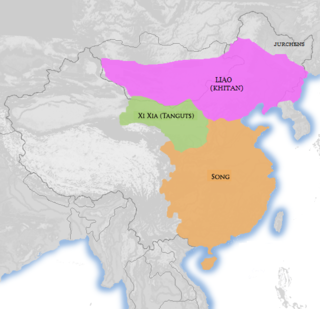
The Western Xia or the Xi Xia (Chinese: 西夏; pinyin: Xī Xià; Wade–Giles: Hsi1 Hsia4), officially the Great Xia (大夏; Dà Xià; Ta4 Hsia4), also known as the Tangut Empire, and known as Mi-nyak to the Tanguts and Tibetans, was a Tangut-led imperial dynasty of China that existed from 1038 to 1227. At its peak, the dynasty ruled over modern-day northwestern China, including parts of Ningxia, Gansu, eastern Qinghai, northern Shaanxi, northeastern Xinjiang, and southwest Inner Mongolia, and southernmost Outer Mongolia, measuring about 800,000 square kilometres (310,000 square miles).

The Tangut people were a Sino-Tibetan people who founded and inhabited the Western Xia dynasty. The group initially lived under Tuyuhun authority, but later submitted to the Tang dynasty. After the collapse of Tang dynasty, the Tanguts established the Western Xia. They spoke the Tangut language, which was previously believed to be one of the Qiangic languages or Yi languages which belong to the Tibeto-Burman family." Phylogenetic and historical linguistic accounts, however, reveal that Tangut belonged instead to the Gyalrongic branch of Tibeto-Burman. Western Xia was annihilated by the Mongol Empire in 1227, most of its written records and architecture were destroyed. Today the Tangut language and its unique script are extinct; only fragments of Tangut literature remain.

The Goryeo–Khitan War was a series of 10th- and 11th-century conflicts between the Goryeo dynasty of Korea and the Khitan-led Liao dynasty of China.
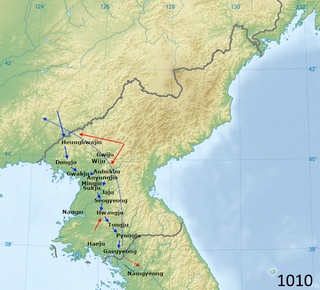
The Second Goryeo-Khitan War was an 11th-century conflict between the Goryeo dynasty of Korea and the Khitan-led Liao dynasty of China near what is now the border between China and North Korea. It was the second of the Goryeo-Khitan Wars, with the First Goryeo-Khitan War occurring in 993, the second in 1010, and the third in 1018.

The Tang dynasty in Inner Asia was the expansion of the Tang dynasty's realm in Inner Asia in the 7th and, to a lesser degree, the 8th century AD, in the Tarim Basin, the Mongolian Plateau, and portions of Central Asia. Wars were fought against the Gokturk Empires and Xueyantuo, but also against many states of Central Asia. This expansion was not steady; for example, the Tang did lose control of the Tarim Basin temporarily to the Tibetan Empire in the 680s, and their expansion north of the Gobi Desert was thwarted in 682. Emperor Taizong's military success was, in part, a consequence of changes he initiated in the Chinese army, including improved weaponry. The emperor placed a new emphasis on cavalry, which was very important because his non-Han opponents used the horse effectively in warfare.

The Miao rebellions in the Ming dynasty were a series of rebellions of the indigenous tribes of southern China against the Ming dynasty, from the 14th to the 15th centuries. The Ming defeated the rebels with overwhelming force. Later, during the Qing dynasty, another series of Miao rebellions broke out.
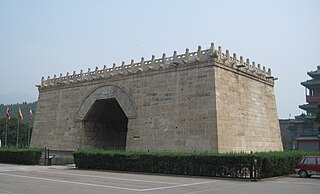
The Cloud Platform at Juyongguan is a mid-14th-century architectural feature situated in the Guangou Valley at the Juyongguan Pass of the Great Wall of China, in the Changping District of Beijing Municipality, about 60 kilometres (37 mi) northwest of central Beijing. Although the structure looks like a gateway, it was originally the base for three white dagobas or stupas, with a passage through it, a type of structure known as a "crossing street tower". The platform is renowned for its Buddhist carvings and for its Buddhist inscriptions in six languages. The Cloud Platform was the 98th site included in the first batch of 180 Major Historical and Cultural Sites Protected at the National Level as designated by the State Council of China in April 1961.

Imre Galambos is a Hungarian sinologist and Tangutologist who specialises in the study of medieval Chinese and Tangut manuscripts from Dunhuang. He is a professor of Chinese Studies at the Faculty of Asian and Middle Eastern Studies at the University of Cambridge, and a fellow of Robinson College, Cambridge.

The Guiyi Circuit, also known as the Guiyi Army, Golden Mountain Kingdom of Western Han, Dunhuang Kingdom of Western Han, was a Chinese regional military command and later an autonomous dynastic regime nominally subordinate to the Tang dynasty, the Five Dynasties, and the Northern Song dynasty. The Guiyi Circuit was controlled by the Zhang family from the second half of the 9th century to the 10th century and then the Cao family until the 11th century. The Guiyi Circuit was headquartered in Shazhou.

The military of the Tang dynasty was staffed with a large population of Turkic soldiers, referred to as Tujue (突厥) in Chinese sources. Tang elites in northern China were familiar with Turkic culture, a factor that contributed to the empire's acceptance of Turkic recruits. The Emperor Taizong of Tang adopted the title of "Heavenly Khagan" and promoted a cosmopolitan empire. Turkic soldiers that served under the Tang dynasty originated from the Eastern Turkic Khaganate. It began with Taizong who sent his general Li Jing, eventually ended in defeating the Eastern Turks and capturing their leader Jiali Khan.

The Ganzhou Uyghur Kingdom, also referred to as the Hexi Uyghurs, was established in 894 around Ganzhou in modern Zhangye. The kingdom lasted from 894 to 1036; during that time, many of Ganzhou's residents converted to Buddhism.
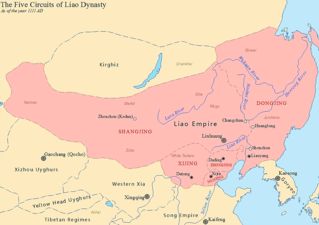
This is a timeline of the history of the Khitans. The Khitans were a nomadic people in Northeast Asia related to the Xianbei. Following the collapse of the Tang dynasty, they established the Liao dynasty in 916, encompassing parts of modern-day China, Mongolia, North Korea, and Russia. The Liao dynasty was eventually conquered by the Jin dynasty in 1125. Remnants of the Liao court led by Yelü Dashi fled westward to Central Asia where they established the Western Liao dynasty. In 1211, the Western Liao throne was usurped by a Naiman called Kuchlug. In 1218, the Mongol Empire defeated and conquered the Western Liao dynasty.

This is a timeline of the Jurchens.
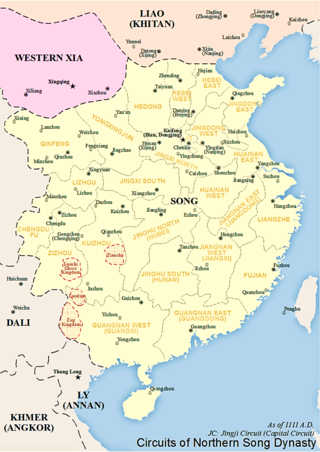
This is a timeline of the Song dynasty (960–1279). The Song dynasty was founded by Zhao Kuangyin, posthumously known as Emperor Taizu of Song, who ended the period of division known as the Five Dynasties and Ten Kingdoms period. The Song dynasty is commonly separated into two historical periods, the Northern Song (960–1127) and the Southern Song (1127–1279), divided by the loss of the north to the Jurchen Jin dynasty (1115–1234). In 1279, the Mongol Yuan dynasty conquered the Song.

This is a timeline of the Five Dynasties and Ten Kingdoms (907–979), which followed the collapse of the Tang dynasty in 907 AD. The Five Dynasties refer to the succession of dynasties which ruled northern China following the Tang collapse while the Ten Kingdoms, with the exception of Northern Han, ruled in southern China. This era of division ended in 979 AD with the rise of the Song dynasty under Emperor Taizu of Song, although the Song would never reconquer the northern territory lost to the Khitans, collectively known as the Sixteen Prefectures.

Tsongkha, also known as Qingtang and Gusiluo, was a Tibetan theocracy that ruled northeastern Tibet from 997 to 1104.
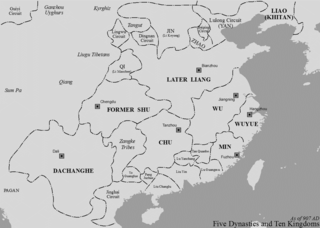
This is a timeline of the Tangut people and the Western Xia dynasty.
This is a timeline of Yunnan and Guizhou.

This is a timeline of the Era of Fragmentation, the period of Tibetan history lasting from the death of the Tibetan Empire's last emperor, Langdarma, in 842 until Drogön Chögyal Phagpa gained control over the three provinces of Tibet in 1253 under Mongol rule.
The Song–Xia wars were a series of military conflicts fought by the Northern Song dynasty, Western Xia dynasty, and Liao dynasty from the late 10th century to early 12th century. Although sporadic conflicts would continue, the Northern Song lost their land border with the Western Xia after the Jin–Song Wars and the Jingkang Incident of 1127 which saw the fall of their capital, Kaifeng, to the Jurchen-led Jin dynasty.
















